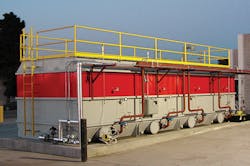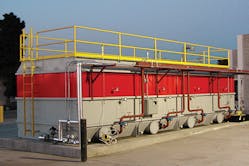The XCeed bioreactor technology from UOP LLC, a Honeywell company, is an enabling process for bulk treatment of contaminants in a variety of applications and diverse waste streams.
The technology is ideally suited for complex, organic wastewater containing fats, greases and high biological oxygen demand (BOD) levels, which are commonly found in food and beverage wastewater streams.
The system's compartmentalized plug-flow design and sophisticated biological population lead to highly efficient treatment with low sludge generation, low operational and maintenance costs, and low component replacement costs.
Customer Challenge
A cheese and dairy factory in upstate New York processes wastewater with high BOD levels due to the presence of sugars, fats, oils and grease, and dissolved proteins. BOD waste and other solids must be removed prior to discharge to the local sewer system.
The local sewer authority imposed surcharges on BOD levels and total suspended solids (TSS) present in the plant's wastewater as it exited the facility. To meet regulatory effluent requirements, a more complex wastewater treatment solution was needed.
Solution
Lowering overall BOD and TSS levels would require separating the non-soluble fats, oils and grease from the soluble sugar and protein molecules and effectively removing them from the wastewater.
The most economical solution for lowering BOD levels was to combine dissolved air flotation (DAF), a pretreatment solution for the removal of insoluble fats, oils and grease, and UOP's XCeed bioreactor technology to remove soluble sugars and protein. These processes were followed by secondary DAF treatment to further reduce TSS levels.
Low energy demand resulted in lower operating and maintenance costs compared to alternative biological treatment processes considered for this system. Further, sludge/solid waste production is approximately 70 to 80 percent less relative to membrane bioreactors (MBRs) and up to 60 to 70 percent less than moving bed bioreactors (MBBRs).
Results
The combination of DAF and the bioreactor technology lowered BOD levels by 77 percent and TSS levels by nearly 65 percent, respectively. The treatment system has consistently met BOD removal targets over a seven-year operational period without unplanned shutdowns or upsets.
UOP's XCeed bioreactor technology has been incorporated in approximately 20 food and beverage applications globally. For more information on UOP LLC and its XCeed bioreactor technology, visit www.uop.com.



